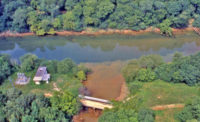Too many construction contractors and engineers don’t fully understand their insurance coverage, and, in particular, what they are covered for and what they are not, notes James Blasting, senior consultant with Arcadis, the water and environmental engineering company.
And one of the biggest misunderstandings among contractors and others looking to be certaom they are insured against construction or design problems is the difference between claims-based coverage and its more all-encompassing alternative, occurrence-based coverage.
Pollution and environmental insurance has never seen lower premiums, higher limits and more flexibility in terms and coverages. But it is also more complicated than the comparatively straightforward designer errors and omissions coverage or a contractor's builders risk policy. A recent ENR survey showed that plenty of companies do not insure pollution and environmental liability risks.
With claims-based insurance, the policy has to be in place when the claim is filed in order for the policy to cover it and the insurance to respond. If it isn’t, you are out of luck.
Blasting has seen cases where a contractor may is hit with a claim and assumed he or she is covered, only to be told by the contractor's insurance broker that it is claims-made and was filed after the policy expired.
“The entity that buys the insurance, it doesn't know enough to ask whether this is occurrence or claims-made,” Blasting said. “They feel like they have coverage until the broker tells them it’s claims-made. I have heard of that happening.”
While the premium on a claims-based policy is likely to be lower, occurrence-based coverage can prevent nasty surprises from happening.
With an occurrence-based policy, you are covered for any bodily injury or damage that occurred during the period you were insured, regardless of when the claim is filed. For example, even if you have cancelled that policy, you are still covered, as long as the accidental release of pollutants, or triggering event, occurred during the time your insurance was in place.
An occurrence-based policy also replenishes an annual limit each year, so a claim filed in one year won’t chew through all your coverage if something else were to happen. By contrast, with a claims-made policy, you have one policy benefit limit to work with during the entire policy period.
“It’s important to know what kind of coverage you had and what it applies to,” Blasting said.
Complexity of Pollution Liability
And insurance coverage gets particularly tricking when it comes to pollution legal liability (PLL) coverage, Blasting argues.
For starters, it is typically claims-based. Second, it is not project cost-overrun insurance and it follows the principal that the insurance does not cover known conditions.
Some insurers used to offer this kind of insurance, picking up the tab, say for a $10 million project that wound up costing $20 million when dealing with the pollution issues on site proved to be more costly.
But companies have gotten out of that line of coverage, which proved to be unprofitable, Blasting said.
Rather, the value of PLL coverage is that it protects you and your company from unknown pollution conditions that may be uncovered during the course of a project.
Say, for example, take a contractor that is working on a brownfields site and getting ready to remove some underground petroleum storage tanks.
The cost of digging up the tanks and removing contaminated soil would not be covered under a PLL policy. But the cost of removing and cleaning up the 50 transformers found under the tanks that no one knew were there would be covered since they constitute an unknown condition, Blasting noted.
Value of the Insurance Coverage
This type of insurance can come in particularly handy during the sale of a development site or corporate acquisitions in which involves real estate or facilities that have contamination of one sort or another, he said.
The engineering firm hired to do the site assessment, for example, comes up with an estimate that it could cost up to $1 million to clear the site of various contaminants.
But then someone at the negotiation table raises the question of what happens is further contamination is found?
In order to move the deal forward, the buyer and seller agree to buy a PLL policy and agree to name the bank which is financing the deal and additional insured in order to put it at ease as well, Blasting explained.
“It can put everyone at ease,” Blasting said. “This helps put everyone at ease.”
More and more, in turn, is now covered under PLL policies, he said. If a milk tank on a dairy farm breaks and spills into a nearby stream, killing fish, this would be considered pollution.
“The good news is that pollution legal liability insurance has a very broad definition of pollution,” Blasting said. “It’s anything that is where it shouldn’t be.”






Post a comment to this article
Report Abusive Comment